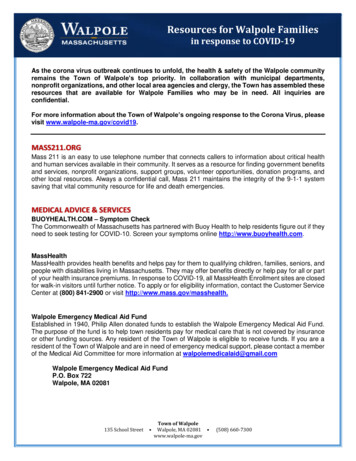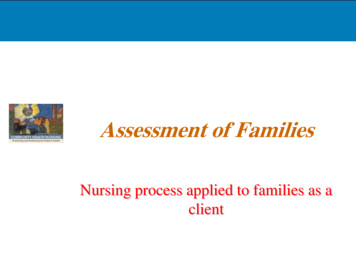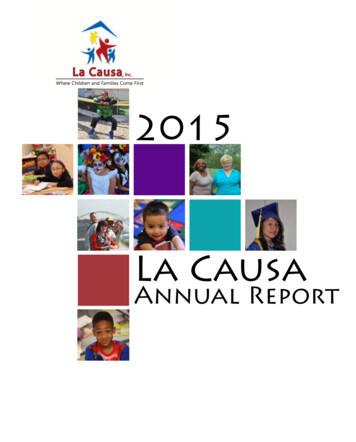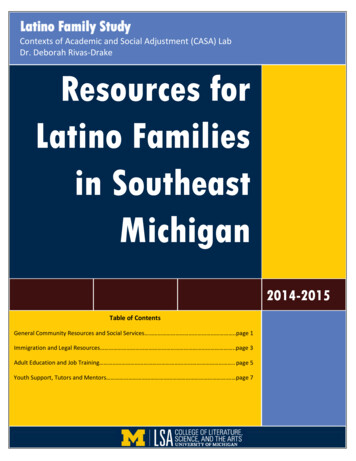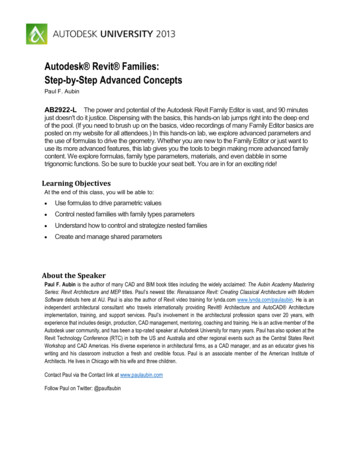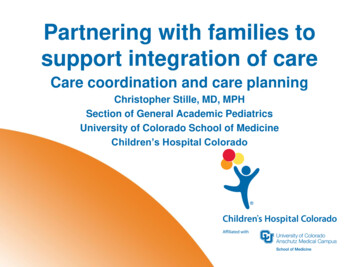
Transcription
Partnering with families tosupport integration of careCare coordination and care planningChristopher Stille, MD, MPHSection of General Academic PediatricsUniversity of Colorado School of MedicineChildren’s Hospital Colorado
Discussion points Central role of children and families Importance of care coordination (CC) to the entire care processEvidence: what do we have/need?Difficulty of CC for children with medicalcomplexity (CMC)Solutions: what works?Policy and payment implications2
WarningThis presentation contains 19 questionmarks.As care coordination and care planningbecome major focus points in health systemchange, we are discovering many insights andsome answers but even more questions.3
Foundational documents Antonelli, McAllister and Popp, Making Care Coordination aCritical Component of the Pediatric Health System(Commonwealth Fund, 2009) Stille et al., The Family-Centered Medical Home (AcademicPediatrics, 2010) AAP Council on Children with Disabilities, Patient and FamilyCentered Care Coordination (policy statement), revised 2014 AHRQ Care Coordination Measures Atlas, updated 2014 Bachman, Comeau, and Jankovsky, The Care CoordinationConundrum and CYSHCN (LPFCH, November 2015)4
DefinitionPediatric care coordination is a patient- and familycentered, assessment-driven, team-based activitydesigned to meet the needs of children and youthwhile enhancing the caregiving capabilities of families.Care coordination addresses interrelated medical,social, developmental, behavioral, educational, andfinancial needs to achieve optimal health and wellnessoutcomes.- Antonelli, McAllister and Popp, 20095
Care Map6
Family’s perspective Care coordination is much more than help in arranging appointments,especially for CMCParents/guardians are ultimatecoordinators (sometimes the only ones)Professionals’ tasks: Support and enhance parents’ roles Do things uniquely enabled by trainingand position7
Why is CC so central in care? Current system: Overall complexity of needs and servicescontinue to increase Fragmented care Increased need for “system navigation” Fee for service payment still predominant Communication suboptimal/not reimbursed National policy changes: Triple Aim Idea: Integration of care will improve quality,safety, and efficiency, while lowering costs andincreasing met needs8
Model: CC as centralprocess in integrated careCarePlanningCareCoordinationIntegratedCare Assessment-driven, created by care coordinator andfamily, input by care team Anticipates needs and potential consequences Use of care plan, response to needs Used by a few team members to inform team Multiple team members including top-level cliniciansadapt their care to changing needs of child, family, andother team members Informs changes to care plan9
Care plan example 6 full pages, 1766 words: here is a smallpartPCP Clinic XX/XX/2014, Special Care Clinic, Dr. XXXXX:PLAN:1. Abdominal Pain- AXR to evaluate stool burden- UA for r/o UTI -- attempted clean catch x 3, also tried using collecting hat, however this wasextremely distressing- did not pursue cath UA since she is not endorsing dysuria, hematuria, urgency, frequency- would also like to minimize traumatic interventions since pt immunosuppressed- advised MOC to monitor her peeing patterns- bowel clean out with miralax- 1 tablespoon in 6oz fluid q2h x 3 doses- may repeat as needed as long as staying hydrated- reviewed titrating miralax dose- recommended considering maintenance bowel regimen to achieve 1 soft stool dailyPCP Clinic XX/XX/2015, Special Care Clinic, Dr. XXXXX:Has had borderline BPs for the last 3 visits. – Cardiologist notified to follow-up at next visitCardiology Plan XX/XX/2015, XXXXXX, FNP- 48 hour Holter to evaluate for any ectopy- Continue with Q2 mo labs and Q4 mo clinic visits for cardiac surveillance- Will need to change Standing lab orders if XXX tolerates the tacrolimus- Be sure to practice good oral hygiene. You are at higher risk of gingival hyperplasia due to beingon maintenance cyclosporine- XXXXX will require SBE prophylaxis prior to any dental procedure- Heart Cath: due May 2016- Parents have agreed to change to pill form Tacrolimus for primary immunosuppression at end ofthe current bottle of Neoral.- Immunosuppression Meds:CYCLOSPORINE 60 mg (0.6 ml) PO BID (goal 50-100), will finish bottle in about 1 weekStart tacrolimus 0.5 mg PO BID (goal 3-5) once finished with Neoral bottle, recheck lab in 1week- Await antiplatelet antibody as recommended by XXXXX, MD (Heme) from curbside discussion onX/XX/15, platelet count is WNL today- Recommend f/u with Neurology regarding "spacing out" or starring spells- Call the on-call Transplant Coordinator at (303) 890-3503 for sudden onset of nausea, vomiting,diarrhea, fever, fatigue, pallor, cold extremities, chest pain, difficulty breathing, heart palpitation,any missed doses or forgetting medications or other questions/concerns that arise10
Care plans Can be simpler: ProblemStatus (active, urgent, stable, )ActivityWho responsible (include parents!)Time frame for followup What’s the right balance of detail vs.practicality?11
Role of care coordinator Expert team member “Glue” between different components ofthe health care system Doctors don’t do a very good job of CC(though they try hard!) Increase met needs for families12
More on coordination andintegration Coordination: Designated carecoordinator (s) use care plan andrespond to family needs Integration: All team members use careplan to harmonize care they provide Example: high risk spine surgery program Requires higher level of communication,thought, and WORK13
“Care coordination” vs.“Case management” Care Coordination: Function of direct care teamNeed-focusedAssessment-basedBroader Case Management: (traditionally) Outside direct care team (e.g. payer)Resource-focusedCriterion-basedNarrower14
Importance of CC:Questions How to get care team members to acommon understanding of theimportance and role of CC? How to change culture of team memberstoward coordination then integration ofcare?15
Evidence: what’s known? Most positive outcomes from adultliterature Disease-specific outcomes Nature of adults/adult disease Less known for kids “non-categorical” outcomes: ED visits, inpatient(re) admissions Quality: family-centered care, access toservices, met needs CC affects processes outcomes16
Evidence: measurement Most CC measures survey-based Little to no relevant administrative data Most population-level data sources Service/resource use Not process focused Difficult to relate processes directly to “hard” outcomesProgress: AHRQ measures update AHRQ/CMS CHIPRA quality measures Centersof Excellence: Seattle Children’s COE4CCN17
Measurement: Questions What kind of CC is most helpful for whatkids, under what circumstances? What are some “care coordinationsensitive outcomes” that cut acrossconditions and situations?18
Challenges in CC for CMC5 Ds: adult-child differences Differential epidemiology Greater number of less-prevalent conditions Longer and more dynamic time course Developmental change Dependency Demography Dollars CMC are poorer Medicaid (50 states) vs Medicare19
Challenges in CC for CMC5 Ds: implications Non-disease specific approach More frequent care plan updates Training and skillsets of coordinators More emphasis on consequences ofpoverty, other social determinants ofhealth More variability between states20
Challenges in CC for CMCSilos of coordination21
Challenges in CC for CMC Multiple care teams May not all be high functioning Multiple points of view Each may have a care coordinator(Parent)22
Challenges in CC for CMCCC is often not driven by a care plan Time-consuming to create and updateplan; often not reimbursed Kids don’t behave according to plansTransitions to adult care: “Round peg in a square system” We know what we should do to fix this but can we?23
Solutions Primary “Care Coordinator” Based at Medical Home Face to face with parents Coordinate across continuum of careincluding between organizations Parent support and training in CC Curricula exist Parent-to-parent networks “Relational coordination” From organizational literature CC from RNs, SW, family navigators, others24
Solutions Non “degree focused” care coordinators Based in care setting: Family navigators (strengths: education,community resources) Not based in care setting: (strengths:community knowledge) Home visiting services Community health workers Peer navigators Challenge: how to communicate best withsystem?25
SolutionsCaveat: innovative, resource-intensive CCsolutions are hard to generalize/sustain!26
More questions How best to allocate CC resources? Forwhom? How to include social determinants ofhealth in CC planning and resourceallocation?27
Policy and paymentprogress Difficulties with fee-for-service model: Do more, get paid more except when you don’t get paid at all (CCnot well reimbursed) Task-based Single-site based Easy to attribute, hard to share responsibility28
Policy and paymentprogress Population-based payment: per-memberper-month (PMPM) Example: CO’s Regional Care CoordinationOrganizations (Medicaid “ACO”) 4.50 PMPM to PCP practices to provide“delegated care coordination” for attributed kids Salary of 1 FTE RN care coordinator: 1667patients (100 CMC) Other states with some form of payment: MI,RI, OR, VT, MA, ?others29
Questions Who can do CC and get paid for it? Qualifications: different for different kindsof CC Parents do the most CC. How do they(not) get paid? CC cuts across service sectors: How to divide payment? Which sector responsible/gets paid?30
Holiday wishBy 2021, every child with medicalcomplexity will have: A care coordination team, including a familynavigator and other appropriate non-physicianprofessional (s), to interact with children andfamilies proactively with the goals of: Supporting CMC and families to promote meetingneeds identified by them Promoting care integration Formulating, implementing and updating a practical,shared care plan Using services efficiently31
Holiday wishBy 2021, every child with medicalcomplexity will have: The team will be adequately paid for through non fee-for-service methods that are portable betweencare settings and payersThe process will be informed by enough data to: Determine how much of which services are needed, atwhat time Enable planning for the needs of other similar children inthe population32
Let’s get started!33
Policy and payment implications 2 . Warning This presentation contains 19 question . Foundational documents Antonelli, McAllister and Popp, Making Care Coordination a Critical Component of the Pediatric Health System (Commonwealth Fund, 2009) . Solutions Primary “Care .



